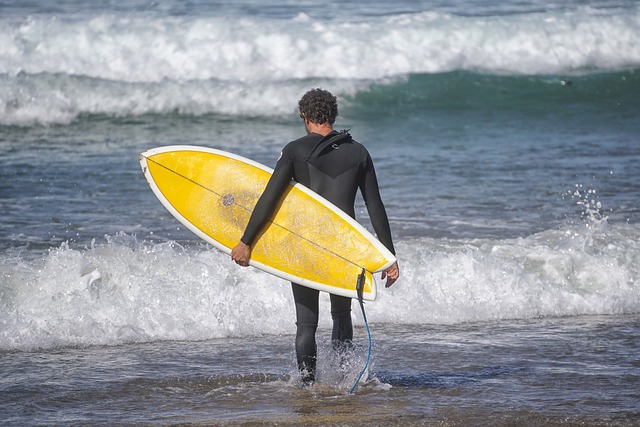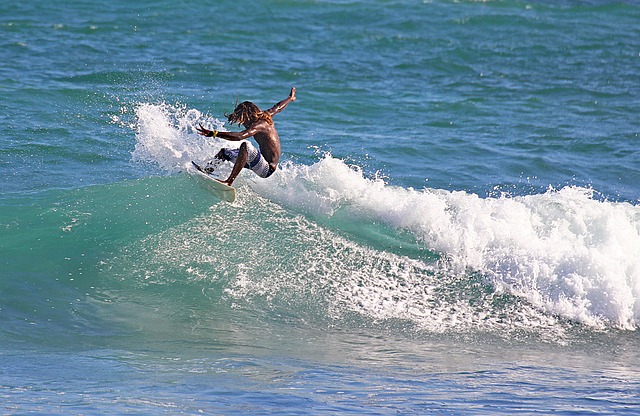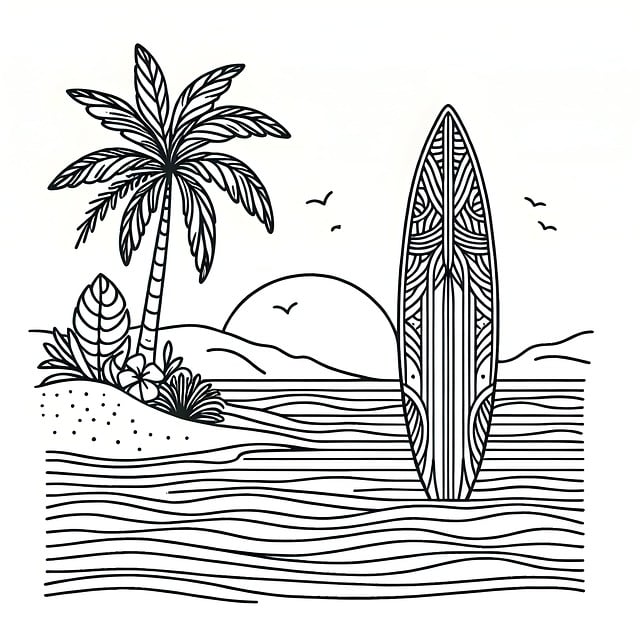For beginner surfers, the essential components of safety and technique are intertwined. A critical element in this equation is the leash, which serves as a lifeline between the surfer and their board. This leash must be the right length to return the board at an appropriate pace, allowing the surfer to regain their position swiftly while avoiding entanglement or trips over the cord. The leash should also be robust and durable, capable of withstanding the rigors of surfing without failing at a critical moment. Comfort is equally important, as a secure and well-fitting ankle strap will prevent slippage and ensure the surfer remains attached to their board throughout the session. Regular inspections are necessary to maintain the integrity of the leash, ensuring it won't let you down when you need it most. With the right leash and proper board handling skills, novice surfers can confidently navigate the initial stages of learning to surf, paving the way for a lifelong passion and enjoyment of the sport.
When venturing into the realm of surfing, particularly as a beginner, mastering the basics is paramount. Among these essentials, a quality leash stands as a silent guardian, ensuring both safety and security during your ride. This article delves into the critical role a surfboard leash plays in keeping you connected to your board amidst the ocean’s dynamic environment. We’ll explore its anatomy, the key features that define a reliable leash for beginners, how to attach it correctly, and common pitfalls to avoid. With insights on choosing the right length and style for your surfboard, along with real-life scenarios highlighting its importance, you’ll be well-equipped to enhance your safety while catching those waves. Whether you’re a novice or an experienced surfer looking to refresh your knowledge, this guide will serve as an indispensable resource for integrating the best surfboard leashes into your surfing practice.
Understanding the Importance of a Quality Leash for Beginner Surfers

For novice surfers, mastering the basics is essential for both safety and enjoyment. A key element in this journey is equipping oneself with a reliable leash, which is more than just an accessory. The leash serves as a critical tether between the surfer and their surfboard for beginners, ensuring that when a wipeout occurs, the board doesn’t escape into the sea’s depths, potentially causing injury or hindering the ability to quickly regain one’s footing and catch the next wave. A high-quality leash, with its durable materials and secure fastening points, provides the assurance that both the surfer and their board will remain connected through the ebb and flow of the ocean’s movements. The right leash should be of appropriate length—not too long to pose a hazard but not so short as to limit mobility—and compatible with one’s surfboard for beginners, ensuring a snug fit that won’t slip off during intense rides or when paddling out beyond the breakers. Investing in a quality leash is a step towards building confidence and enhancing the overall experience of learning to surf, as it allows beginners to focus on their skills without the added worry of losing their board in the vast ocean waters.
Key Features to Look for in a Surfboard Leash for Safety

When selecting a surfboard leash for safety, especially for beginner surfers, several key features should be taken into consideration to ensure both the user’s security and the leash’s functionality. Firstly, the material used in the leash is paramount; high-quality rubber or neoprene provides optimal stretch and recoil, which can significantly reduce the risk of injury by preventing the board from striking you upon a wipeout. The length and thickness of the leash also play crucial roles. A standard length is typically between 3 to 8 feet, accommodating both small and large surf conditions; however, for beginners, a slightly longer leash can offer more freedom of movement while still maintaining a safe connection to the board.
Additionally, the strength and durability of the leash’s cord cannot be overstated. A robust cord resists breaking under stress, which is particularly important when catching waves or during intense surfing situations. The swivel ankle cuff should be comfortable, well-padded, and designed to fit securely without pinching or causing discomfort over extended periods. It’s also beneficial to have a leash with an adjustable cuff to ensure a snug yet non-restrictive fit for different ankle sizes. For beginners, a surfboard leash with these features will provide the necessary safety assurances while learning and improving their surfing skills. Always prioritize quality and functionality over cost when selecting a leash, as it is a critical piece of equipment that can prevent loss of your board and potential injury during surfing activities.
The Anatomy of a Surf Leash: How It Keeps You Tethered to Your Board

A surf leash is a critical piece of equipment for both novice surfers using a surfboard for beginners and seasoned professionals alike, serving as a safety tether between the surfer and their board. The anatomy of a surf leash typically includes a durable elastic cord, a strong ankle cuff, and a swivel attached to a rail saver that clips onto the surfboard. The elastic cord is designed to stretch under pressure but maintain a connection, ensuring the board doesn’t escape and become a hazard. The cuff is ergonomically constructed to fit securely and comfortably around the surfer’s ankle, preventing the loss of the board during wipeouts or when riding the wave. The swivel mechanism allows for 360-degree motion, eliminating the risk of the leash getting tangled or caught on objects underwater, which could potentially cause injury. This design is crucial for maintaining safety and allowing surfers to focus on the thrill of the ride without the added concern of losing their board. For those new to surfing, a high-quality surfboard for beginners often comes with a leash included, ensuring that from their first wave, they are equipped with this vital safety feature.
Choosing the Right Leash Length and Style for Your Surfboard

When selecting a leash for your surfboard, particularly if you’re a beginner, it’s crucial to consider both the length and style that suits your needs. The right leash length ensures safety and efficiency in your surfing maneuvers. Ideally, the leash should be long enough to connect you to the board without causing unnecessary entanglement or drag. For beginners, a standard leash length of about 7 to 10 feet is often recommended. This allows for a balance between being able to recover your board after a wipeout and having enough mobility to enjoy your ride. Additionally, the leash’s style—coiled or straight—plays a role in your surfing experience. A coiled leash, which absorbs some of the stretch, can be more responsive and may be preferable for beginners who want a quicker return to their board. In contrast, a straight leash offers less stretch and might be better suited for more experienced surfers in bigger waves where the force upon impact with the water is greater. Regardless of your choice, ensure that the leash’s swivel mechanism is smooth and secure, as this will help prevent leash kinks or twists that can hinder your ability to maintain control of your board. By carefully considering these aspects, beginners can select a surfboard leash that enhances their safety and enjoyment while learning the art of surfing.
Step-by-Step Guide on Attaching a Leash to Your Surfboard Correctly

When venturing into the world of surfing, especially as a beginner, mastering the basics is paramount to ensure both safety and enjoyment. One critical aspect is correctly attaching a leash to your surfboard. This step-by-step guide will help you secure your leash in a manner that promotes optimal performance and safety while riding the waves.
To begin, lie on your board with the front of the leash facing upwards, towards the nose of the board. The Velcro end should be on top, while the cord extends downward. Take the ankle strap and step into it, ensuring it’s snug but not too tight. Next, route the cord along the rail (the edge of the board) nearest to your dominant foot. This placement is crucial as it allows for a quick reconnection should you wipeout and become separated from your board. The leash should hang loosely between your ankle and the board when in the water.
Once the cord is correctly positioned, secure the Velcro flap around the tail of your surfboard. Make sure the Velcro is fastened firmly but not so tight that it’s difficult to undo in case of a fall. The leash should be attached in such a way that when you lie on the board, there are no twists or tangles in the cord. Afterward, stand up and check that the leash is neither too long nor too short; ideally, it should be long enough to allow for a few strides but not so long that it becomes a hazard. Remember, the leash’s primary function is to keep you tethered to your board, ensuring it doesn’t escape and hit other surfers or swimmers, and to enable you to quickly regain your board after a wipeout. For beginners, this attention to detail in attaching the leash can make a significant difference in their surfing experience and safety.
Common Mistakes to Avoid When Selecting and Using a Surf Leash as a Beginner

When selecting a surfboard for beginners, it’s crucial to consider the leash as an integral safety component. A leash connects the surfer to the board, ensuring it doesn’t escape into the impact zone where it could cause injury to others or get lost. Common mistakes often arise from a lack of understanding about leashes and their functions. Firstly, opting for a leash that is too long can lead to complications, such as the board returning to you faster than you can react, potentially causing falls or tripping over the leash itself. This can be particularly problematic in crowded lineups where quick maneuvering is necessary. Conversely, a leash that is too short may not provide enough length for the surfer to have a safe range of motion and could result in the board not returning far enough to avoid hazards or reaching safety if one wipes out.
Another frequent error is selecting a leash without considering its suitability for the wave conditions and your surfboard type. For example, high-performance leashes are designed for advanced surfers who ride shorter boards and perform maneuvers that require the board to return quickly. As a beginner, you’ll likely need a standard leash that offers a balance between speed and control. Additionally, the quality of the leash should not be underestimated; a durable leash made from strong, high-quality materials will last longer and provide better performance than a less robust option. Ensure that the leash’s strap is comfortable and securely fastened around your ankle or foot, as this will affect both your control and safety in the water. Lastly, always inspect your leash before heading out to surf, checking for any signs of wear or damage that could compromise its functionality. By avoiding these common mistakes and selecting the appropriate leash for your surfboard for beginners, you’ll enhance your safety and overall surfing experience.
Real-Life Scenarios: Why a Reliable Leash is Critical for Beginner Surfers

For novice surfers, mastering the basics on a surfboard for beginners is just the first step in embracing the sport. Beyond the initial learning curve, safety measures are paramount to ensure a positive and safe experience. A reliable leash, connecting the surfer to their board, plays a critical role in this regard. It’s not just about adhering to safety protocols; it’s about the peace of mind that comes with knowing you’re tethered to your floatation device should you wipe out or lose grip. In real-life scenarios, the leash can mean the difference between a harmless fall and an injury. For instance, during a particularly challenging wave in crowded lineups, a beginner surfer might be separated from their board. Without a reliable leash, they risk losing the board entirely, which could become a projectile, potentially striking other surfers or swimmers. Moreover, in situations where currents are strong or there are powerful rip tides, a leash ensures that the surfer doesn’t get dragged underwater against their will, or that they can easily retrieve their surfboard for another attempt after a spill. The importance of a quality leash cannot be overstated, especially for those embarking on their surfing journey with a surfboard designed for beginners. It’s an essential piece of equipment that complements the learning process and helps to maintain safety standards in the dynamic and sometimes unpredictable ocean environment.
